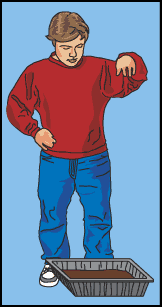|
|
 |
What
to Do
To
begin the activity, fill one of the basins with flour about
1 1/4 to 1 1/2 inches (3-4 centimeters) deep. Sprinkle
a little cocoa on the surface. This will make the changes
caused by the pebbles more visible. Gather the various pebbles;
they will be the "meteoroids."
|
|
|
E X P E R I M E N T 1
Testing
the Size of the Meteoroid |
 |
Pick
out one of the smallest pebbles and have a family member volunteer
to drop (not throw) the pebble from about eye level into the basin.
|
 |
Describe
what you observe, and try to predict the appearance of a crater formed
by a larger pebble dropped from the same height.
|
 |
Then
have your volunteer drop a medium size pebble from about the same
height. What is different about the crater?
|
 |
Have
the volunteer drop the largest pebble from the same height. |
 |
Record
the results on your data sheets.
|
| |
 |
| Meteor
Crater near Winslow, Arizona was formed by an impact that happened
50,000 years ago. An explosive force greater than 20 million
tons of TNT left a crater 700 feet deep (210 meters) and over
4,000 feet (1,200 meters) across. |
|
E X P E R I M E N T 2
Testing
the Speed of the Meteoroid |
 |
Pick
out three or four pebbles of roughly the same (medium) size. Smooth
over the flour and sprinkle on a little more cocoa. For a test comparison,
have the smallest family member drop one of the pebbles from eye level. |
 |
Try
to predict the appearance of a crater formed by a pebble of the same
size dropped at a higher level. |
 |
Have
the next person drop pebbles in at successively higher levels. |
 |
Have
the tallest family member drop the pebble from as high of a distance
as he/she can. Make sure that all trajectories are vertical for consistency
in the test. |
 |
Record
the results on your data sheets.
|
E
X P E R I M E N T 3
Testing
the Angle of Impact |
 |
Smooth
the flour and sprinkle on more cocoa. Have someone throw a medium-sized
pebble with moderate force vertically into the basin. Then try to
predict the appearance of a crater if the meteoroid strikes the ground
at an angle. |
 |
The
next person should throw a similar sized pebble at about the same
speed, but at a slight angle. Discuss the shape of the new crater
and predict how the shape of the crater will change as the angle of
impact increases.
|
 |
Continue
throwing pebbles into the basin, taking care to throw the same sized
rocks at the same speed, but at varying angles. Discuss further the
shape of the craters. |
 |
Record
the results on your data sheets. |
|
What's Going On
The
results of this test are often very surprising. One would normally
expect the crater to have an oblong shape on extremely wide-angle
impacts. In fact, all craters that we have seen on the Moon and
Earth are pretty much circular. The reason is that an explosion
occurs on impact and the forces associated with an explosion are
always spherically symmetrical.
|
|
|
This
activity was derived and modified from "Experimenting with Craters,"
an activity in the Great Explorations in Math and Science (GEMS) teacher's
guide, Moons of Jupiter, ©1993
UC Regents. GEMS is a series of more than 50 guides and handbooks
developed at the Lawrence Hall
of Science.
|


